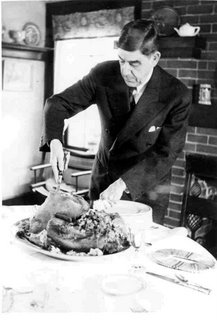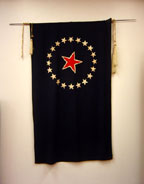Sometime between February, 1920 and October, 1921, the poet Vachel Lindsay annotated a copy of Walled Towns by Ralph Adams Cram and inscribed it to Lyna Chase Souther, a socialite of Lindsay's hometown, Springfield, Illinois.
Cram was an important Gothic revival architect and a disciple of John Ruskin, the pre-eminent Victorian art critic who was also an important influence on Lindsay. Walled Towns, first published in 1919, proposes intentional communities surrounded by metaphorical walls keeping in local talent and keeping out the modernism and commercialism of the industrial age. Cram’s protest to the contrary notwithstanding, Walled Towns falls into the utopian genre.
Lindsay found much to agree with in Walled Towns, which appeared just at the time he was hammering out his own utopian novel, The Golden Book of Springfield. Areas of disagreement with Cram, however, provoked lively responses by the poet penned in the margins of the book in his lovely Spencerian hand. Lindsay's commentary provides insights into his thinking during this time and sheds light on some of the more obscure aspects of his Golden Book. Although Lindsay never mentioned The Golden Book in his Walled Towns annotations, the connection is obvious.
Lindsay intended his Golden Book to transform Springfield.
"You haven’t the least notion of the heart’s blood I am putting into The Golden Book," he wrote to Harriet Monroe, "I would certainly die for the book, if it would do the work I want it to do."
"This book seems to me to be the one thing that justifies my life," he wrote later.
Considering the many important changes that were occurring in Springfield and America while Lindsay was writing The Golden Book, anything must have seemed possible to him at the time. Springfield’s elite had recently commissioned a survey by the Russell Sage Foundation that prompted many social reforms and structural improvements for the city. With the "war to end all wars" just concluded, America embraced Prohibition and women’s suffrage. The country was poised to enter the Jazz Age with its Lost Generation while Lindsay desperately worked to steer things in the opposite direction. It is one of those tragic ironies that the Prohibition amendment which Lindsay himself had helped bring about - and hoped would redirect American culture - ultimately fostered the lawlessness and dissolution that characterized the Roaring Twenties.
Lindsay drew upon many sources for The Golden Book, not the least of which was his already prodigious body of poetry and the rich metaphorical language he developed in that work. John Ruskin, Edward Bellamy and Ralph Adams Cram were already important influences in his thinking and writing. Lindsay's great ambition in The Golden Book was to orchestrate these disparate elements into a cohesive whole. However, without the benefit of a thorough understanding of his literary parentage and his own particular metaphorical language, The Golden Book of Springfield can come across as hopeless nonsense. Lindsay’s writing often demands a fair degree of effort and indulgence from its readers, but The Golden Book of Springfield can strain even the patience of his most ardent devotees.
Lindsay's gift of his hand-annotated copy of Walled Towns to Lyna Souther - with the request that she share the book among her friends in the Springfield Art Association - apparently was intended to enlighten and influence the prominent people and community leaders of Springfield. The "debate," as Lindsay dubbed it, between Cram and himself might help him lay the groundwork for acceptance of his Golden Book in the Springfield community and attest to his earnestness in transforming the town.
Lyna Chase Souther, a talented landscape painter herself, and the sister of Woodstock founder, Frank Swift Chase, was an obvious ally to enlist in this cause. Lindsay had recently collaborated with Souther and the Art Association in the creation of Springfield’s municipal flag. The flag became a prominent component of The Golden Book and fit well with Lindsay's and Cram's shared penchant for civic heraldry and pageantry.
If Lindsay saw Lyna Souther as part of the solution in Springfield, he must have seen her husband, Latham Souther, as part of the problem. It is apparent from his letters that he saw Latham, a banker who happened to be the trust officer of his father’s estate, as the very embodiment of the main street businessman he had waged war against and felt oppressed by throughout his career. Souther was described in one of the congratulatory volumes of local biography and history as one of Springfield's "representative men." As such, he appears to have represented the side of Springfield that resisted Lindsay's ideas the most. It is not very likely that Latham would have reacted any differently to The Golden Book than would have George Babbitt himself.
Although utopias such as Edward Bellamy's Looking Backward 2000 - 1887 had been a very popular literary form in the past – the science fiction of their day - and had inspired much discussion, the critics and the public at large failed even to acknowledge The Golden Book of Springfield when it appeared in 1920. As a vehicle for rallying Springfield and America to his vision, it was a tragic failure for Lindsay.
The copy of Walled Towns inscribed to Lyna Souther, the annotations of which are transcribed here, now resides in the Sangamon Valley Collection in Springfield, a gift of her daughter, Betty McMinn.
Included with the book in the collection are two loose letters, one from Lyna's friend, Charles Ridgely, returning the book to her in 1923 along with a 1921 letter from Ralph Adams Cram to Ridgely saying he would like to see Lindsay's annotations.
Cram never saw this annotated copy, but mentioned in his letter that he had heard from his friend Stephen Graham that Lindsay had distributed twenty or thirty copies of the book. Cram referred to Lyna's copy of Walled Towns as "the annotated copy" in his letter, but Lindsay apparently handed out many such annotated copies to friends and neighbors over the years. Lindsay later referred to these as "illuminated" copies.
Read the transcripition here.
 I grew up thinking of this man, my great-grandfather Latham T. Souther, in terms of George Bailey from Frank Capra's It's a Wonderful Life. It's clear that my hero, Vachel Lindsay, would have thought him more in the mold of Old Man Potter.
I grew up thinking of this man, my great-grandfather Latham T. Souther, in terms of George Bailey from Frank Capra's It's a Wonderful Life. It's clear that my hero, Vachel Lindsay, would have thought him more in the mold of Old Man Potter.








